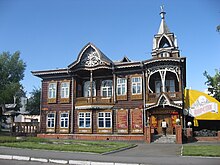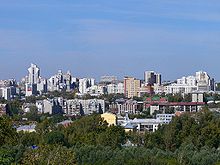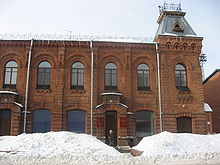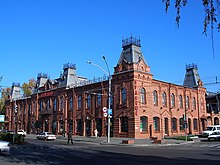Barnaul
| city
Barnaul
Барнаул
|
||||||||||||||||||||||||||||||||||||||||||
|
||||||||||||||||||||||||||||||||||||||||||
|
||||||||||||||||||||||||||||||||||||||||||
| List of cities in Russia | ||||||||||||||||||||||||||||||||||||||||||
Barnaul ( Russian Барнау́л ) is the capital of the Russian region Altai in the south of Western Siberia with 612,401 inhabitants (as of October 14, 2010).
Geography and administration
The city is located 200 km southeast of Novosibirsk and 280 km from the border with Kazakhstan . It is located on the West Siberian main river Ob on the eastern edge of the Barabasteppe in a sandy area.
The city of Barnaul is the administrative center and largest city of the Altai region , which surrendered around a third of its territory when the Altai Republic split off with the capital Gorno-Altaisk .
Sergei Dugin , who was re-elected in December 2017, has been mayor since 2015 .
climate
Barnaul has a continental climate with very cold winters and warm summers.
| Barnaul | ||||||||||||||||||||||||||||||||||||||||||||||||
|---|---|---|---|---|---|---|---|---|---|---|---|---|---|---|---|---|---|---|---|---|---|---|---|---|---|---|---|---|---|---|---|---|---|---|---|---|---|---|---|---|---|---|---|---|---|---|---|---|
| Climate diagram | ||||||||||||||||||||||||||||||||||||||||||||||||
| ||||||||||||||||||||||||||||||||||||||||||||||||
|
Average monthly temperatures and rainfall for Barnaul
Source: Roshydromet
|
|||||||||||||||||||||||||||||||||||||||||||||||||||||||||||||||||||||||||||||||||||||||||||||||||||||||||
history
Barnaul is one of the oldest cities in Western Siberia. It was founded as a Cossack fort in 1730 and has been a town since 1771. Until 1867 it was the second official mining town in Russia alongside Yekaterinburg .
From 1727 criminals and political prisoners were exiled to Siberia , whereupon the population increased rapidly and a lot of cheap labor became available. For this reason, the industrial dynasty Demidow ( Akinfi Demidow , 1678-1745) built a copper smelter in 1730 at the mouth of the Barnaulka in the Ob , around which a town developed. The copper smelter was located near the river, which made it easier for the machines to be transported and the copper to be removed. In addition, the proximity to the forest, and thus to the fuel wood, was ideal. The long transport routes from the copper mines to the copper smelters for further processing have been shortened considerably and costs have been reduced. Thus the first industrial center of Siberia was created.
A few years later, silver ores were found in the Altai. The first silver smelter and forge was set up in Barnaul. They existed from 1744 to 1893. During this period, about 7.4 tons of silver were mined per year, the entire region mined 90% of the silver in all of Russia. On May 1, 1747, Tsarina Elisabeth Petrovna issued a decree expropriating Barnaul's industry and took over the city as the center of silver in state hands.
In 1753 a small mining school was founded in Barnaul, the completion of which entitles to attend the higher mining college in Saint Petersburg . This amalgamation of training and place of work led to the further growth of the city.
From 1771 Barnaul was the second official mining town in Russia, the associated privileges , such as B. the right to own money , strongly influenced the development of the city, which was characterized by extensive industrial settlement. In 1779 a higher technical college for mining, as it existed in St. Petersburg, was founded as a logical further development.
In 1823 Friedrich August von Gebler founded the "Natural History Museum" in Barnaul. The first meteorological observatory in Siberia was built in Barnaul in 1838.
In subsequent years, the border trade gained with Mongolia after 1902 completed expansion of Tschujska tract as a navigable trade route along the ridge of the Altai Mountains in Barnaul more and more importance and was an important trading branch. The connection to the railway network in 1915 was the opening for Barnaul to larger areas of influence and trade in Siberia. However, the Trans-Siberian Railway runs 200 kilometers north in Novosibirsk .
In 1917 there was a major fire in Barnaul, which destroyed large parts of the city. In the course of the reconstruction, Barnaul was redesigned according to the principle of the garden city , which clearly shapes the current character of the city.
As part of industrialization during the Stalinist era , the Trans-Siberian Railway was further expanded with the commissioning of the Turksib in 1934, which made Barnaul an important transport hub in the region.
Population development
| year | Residents |
|---|---|
| 1835 | 9,100 |
| 1860 | 11,600 |
| 1879 | 13,529 |
| 1897 | 21,073 |
| 1916 | 71,200 |
| 1939 | 148.162 |
| 1959 | 305.046 |
| 1970 | 439.134 |
| 1979 | 533.263 |
| 1989 | 601.811 |
| 2002 | 600,749 |
| 2010 | 612.401 |
| 2012 | 621,669 |
Note : 1897 and since 1939 census data
Culture and sights
The cultural life in Barnaul takes place mainly in theaters, of which there are five in Barnaul, and in the local Philharmonic . The city's three museums complement the cultural houses or centers typical of Russia, of which Barnaul can boast twelve.
Many Russian Germans live in Barnaul . Therefore, with German help, a Russian-German house was built in Barnaul that functions as a cultural center. The Goethe-Institut also operates a language learning center in Barnaul that offers German courses.
The Altai region in the Halbstadt (Russian Galbschtadt) and Slavgorod districts is one of the important settlement areas of the Russian Germans, whose history goes back to the deportation of Germans from all over western Russia to the region around Barnaul on Stalin's orders, as well as to the settlement policy of Catherine the Great who recruited people from Germany at the time of their reign . 69,000 people of German descent live there today (as of 2004). In 1991 an "Autonomous District of the Germans" ( Russian Nemezki nazionalny rajon ) with the administrative center Halbstadt ( Russian Galbschtadt ) was set up for them.
Worth mentioning are the large sports stadiums, swimming pools and especially the “Ob” sports complex, where major sporting events regularly take place.
economy
More than 100 industrial companies employ around 120,000 people in Barnaul, making the city the industrial center of the region. Products such as diesel, tires, metalworking machines (melting furnaces, lathes, ...), synthetic fibers , steam boilers, technical carbon , drilling machines, ammunition , woolen clothing, furniture, shoes, diamonds, etc. are manufactured or processed here.
education
There are currently more than 1,200,000 books in the 30 libraries, although Barnaul cannot be counted among the educational centers of the size of Novosibirsk . Nevertheless, Barnaul is definitely the center for education in its region with more than 10 further education institutions (universities, adult education centers etc.) with around 22,000 students.
Colleges
- Altai Region State Medical University
- State Pedagogical University of the Altai Region
- I.-I. Polsunov State Technical University of the Altai Region
- State University of Agricultural Sciences of the Altai Region
- State University of the Altai Region
- State Institute of Culture of the Altai Region
- Altai Academy of Economics and Law
- Barnaul Institute of Law of the Ministry of Interior of Russia
- Economic and Legal Institute of the Altai
- Branch of the All-Russian Remote Institute of Finance and Economics
- Branch of the Russian Remote Textile and Light Industry Institute
Sports
In football, the city is represented by the Dynamo Barnaul club . The city is also home to the Altai Barnaul ice hockey team , which replaces Motor Barnaul , which was dissolved in 2006 .
Town twinning
Barnaul lists the following twin cities :
-
 Flagstaff , United States
Flagstaff , United States -
 Zaragoza , Spain
Zaragoza , Spain -
 Baicheng in Jilin , People's Republic of China, since 1992
Baicheng in Jilin , People's Republic of China, since 1992 -
 Changji in Xinjiang , People's Republic of China, since 2006
Changji in Xinjiang , People's Republic of China, since 2006 -
 Öskemen , Kazakhstan, since 2012
Öskemen , Kazakhstan, since 2012
sons and daughters of the town
- Ivan I. Polsunow (1728–1766), Russian inventor, invented the world's first two-cylinder engine
- Leonid Potapow (1905–2000), ethnologist and historian
- Vera von Schalburg (1907–1946), German agent
- Rita Streich (1920–1987), German singer
- Boris Kulagin (1924–1988), ice hockey player and coach
- Tatjana Talyschewa (* 1937), long jumper and hurdler
- Aghybaj Smaghulow (* 1956), Kazakh diplomat
- Vladimir Shamanov (* 1957), officer
- Eugenijus Ališanka (* 1960), Lithuanian poet, translator and essayist
- Vladimir Popov (* 1962), wrestler, world champion and European champion
- Konstantin Scherbakov (* 1963), pianist
- Julia Neigel (* 1966), German singer, songwriter and music producer
- Jelena Schalina (* 1969), cross-country skier and biathlete
- Alexei Smertin (* 1975), soccer player and politician
- Witali Denissow (* 1976), cross-country skier
- Mikhail Jakubow (* 1982), ice hockey player
- Alexei Jakimenko (* 1983), saber fencer
- Alexei Pepeljajew (* 1984), ice hockey player
- Wiktor Drugow (* 1986), ice hockey player
- Andrei Gretschin (* 1987), swimmer
- Artemi Lakisa (* 1987), ice hockey player
- Denis Kurepanov (* 1988), ice hockey player
- Ivan Vishnevsky (* 1988), ice hockey player
- Jelena Arshakova (* 1989), middle-distance runner
- Alexander Jerochin (* 1989), football player
- Andrei Kolesnikow (* 1989), ice hockey player
- Alexei Tscherepanow (1989–2008), ice hockey player, trained in Barnaul
- Sergei Schubenkow (* 1990), athlete
- Eduard Popp (* 1991), German wrestler
- Alexander Shirov (* 1991), football player
- Yegor Petuchow (* 1994), Russian-Kazakh ice hockey player
- Maxim Simin (* 1994), racing driver
- Viktor Muschtakow (* 1996), speed skater
- Alexander Sobolev (born 1997), football player
- Polina Miller (* 2000), athlete
- Andrei Swetschnikow (* 2000), ice hockey player
Web links
- Barnaul - the capital of Altai region. In: Website of the Altai region. Archived from the original on April 12, 2018 ; accessed on July 20, 2018 .
- barnaul.org - Website of the city of Barnaul (Russian)
- Konstantin Metelnitskij (Константин Метельницкий): Покровский кафедральный собор. Russian Orthodox Metropolitan Altai (Алтайская митрополия Русской Православной Церкви), October 14, 2016 (Russian, page on Pokrovsky Cathedral).
Individual evidence
- ↑ a b Itogi Vserossijskoj perepisi naselenija 2010 goda. Tom 1. Čislennostʹ i razmeščenie naselenija (Results of the All-Russian Census 2010. Volume 1. Number and distribution of the population). Tables 5 , pp. 12-209; 11 , pp. 312–979 (download from the website of the Federal Service for State Statistics of the Russian Federation)
-
^ Central Administrative Board of Social Welfare and Overcoming the Effects of Nuclear Tests at Semipalatinsk of Altai Region. In: Website of the Altai region. Archived from the original on April 12, 2018 ; accessed on July 20, 2018 . The mayor of Barnaul, the newly elected United Russia Sergey Dugin. In: freenews-en.tk. December 4, 2017, accessed July 20, 2018 .














